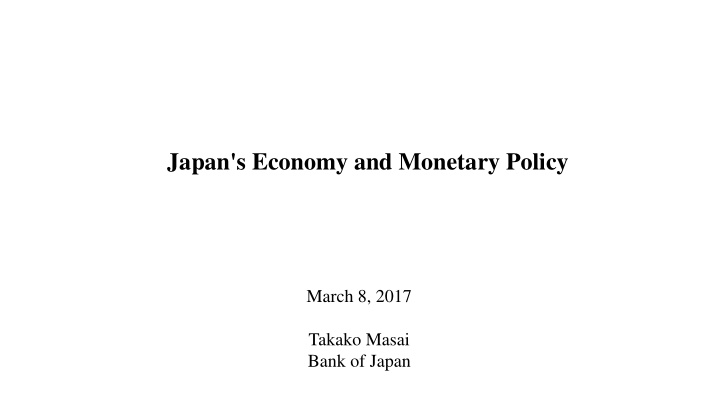



Japan's Economy and Monetary Policy March 8, 2017 Takako Masai Bank of Japan
Chart 1 1999 年 2 月 「ゼロ金利政策」の開始 Changes in the Bank's Monetary Policy Management Introduction of the zero interest rate policy ( - Aug 2000 ) Feb 1999 Introduction of the quantitative easing policy ( - Mar 2006 ) Mar 2001 Mar 2006 Release of "The Bank's Thinking on Price Stability" Dec 2009 Release of "Clarification of the 'Understanding of Medium- to Long- Term Price Stability'" Oct 2010 Introduction of the comprehensive monetary easing policy Feb 2012 Introduction of the "price stability goal in the medium to long term" Jan 2013 Introduction of the "price stability target" of 2 percent 〃 Release of "Joint Statement of the Government and the Bank of Japan on Overcoming Deflation and Achieving Sustainable Economic Growth" Apr 2013 Introduction of Quantitative and Qualitative Monetary Easing (QQE) Oct 2014 Expansion of QQE Jan 2016 Introduction of QQE with a Negative Interest Rate Sep 2017 Introduction of QQE with Yield Curve Control
Chart 2 Mechanism of QQE Quantitative and Qualitative Monetary Easing (QQE) Strong and clear commitment to Large-scale purchases of JGBs achieve the price stability target of 2 percent Decrease Increase Nominal interest rates - Inflation expectations = Real interest rates ⇒ ⇒ ⇒ Decrease Improvement in the economy and increase in prices
Chart 3 Consumer Prices y/y % chg. 3 CPI (all items less fresh food and energy) 2 CPI (all items less fresh food) 1 0 -1 -2 -3 07 08 09 10 11 12 13 14 15 16 CY Notes: 1. Figures for the CPI (all items less fresh food and energy) are calculated by the Research and Statistics Department, Bank of Japan. 2. Figures for the CPI are adjusted to exclude the estimated effects of changes in the consumption tax rate. Source: Ministry of Internal Affairs and Communications.
Chart 4 The 10 Strategic Public-Private Joint Projects toward GDP of 600 Trillion Yen 1. The fourth industrial revolution 2. Toward a world leading healthcare country 3. Overcoming environmental and energy constraints and expanding investments 4. Changing sports to a growth industry 5. Revitalizing markets for transaction of existing houses and reform 6. Improving productivity in the service industry 7. Bringing about revolution among small and medium-sized firms and micro firms 8. Promoting proactive agriculture, forestry and fishery, as well as reinforcing exports 9. Realizing Japan as a tourism-oriented country 10. Taking measures to stimulate domestic consumer sentiment Source: "Japan Revitalization Strategy 2016" (Cabinet Decision, June 2, 2016)
Recommend
More recommend